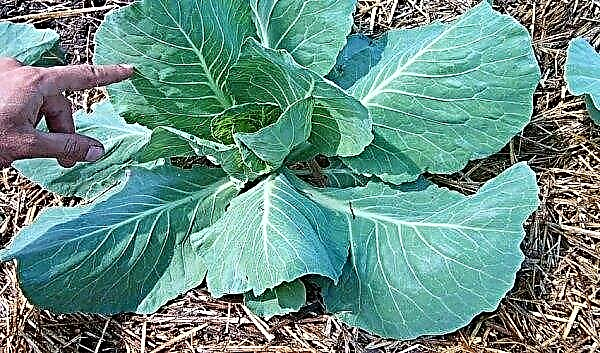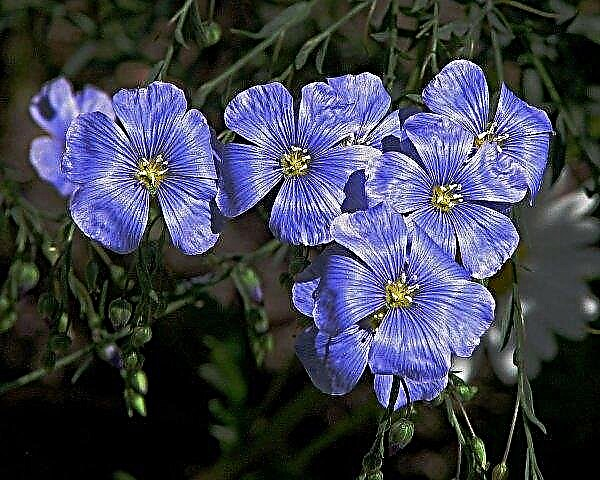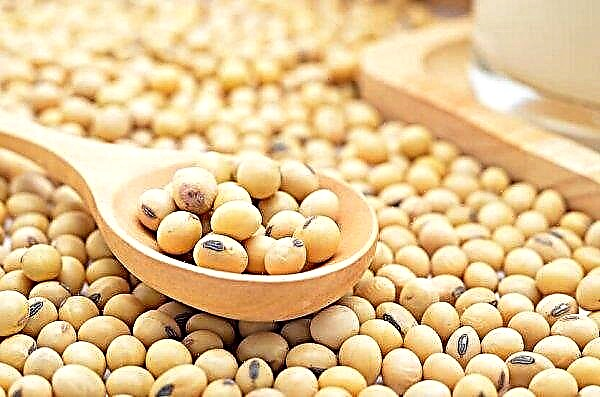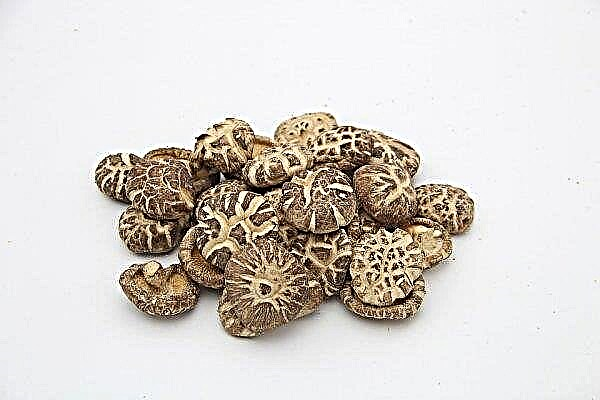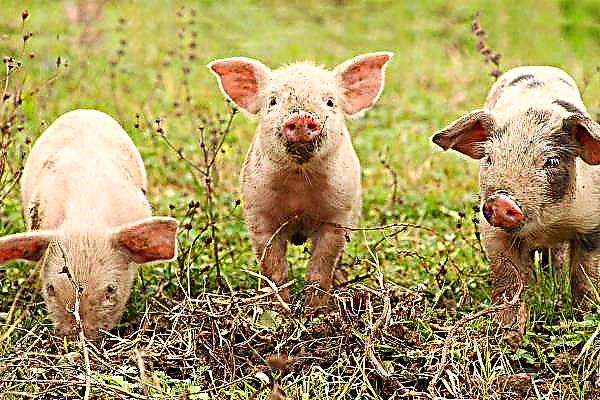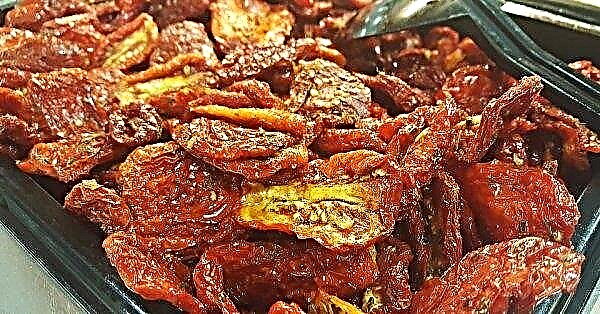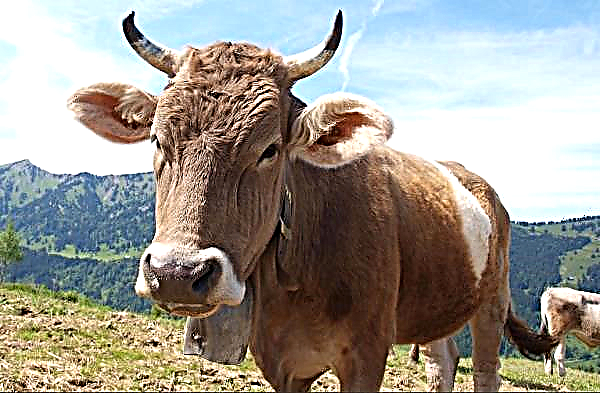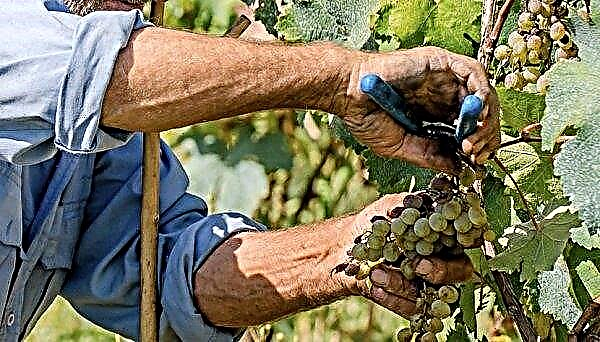Among the large number of varieties of hydrangeas, special attention is given to the new large-leafed variety Leuhfeyer (Hydrangea macrophylla Leuchtfeuer). It has a high decorative effect and looks great in different compositions or solo landings. However, before starting the cultivation of the plant, it is recommended to study its features, since it is demanding regarding care.
Description of the variety Leuchfeier
Hydrangea of the Leuchfeier variety (this unusual name for us is sometimes pronounced Lichtfaer or Lichtfire) is a perennial, beautifully flowering shrub. In the subtropical climate, its height reaches 4 m, in the northern latitudes it does not exceed 1-2 m. The shoots of the plant are upright. Last year's lignified, this year - grassy, green, lignified only a year later. The leaves are simple, egg-shaped, painted green.
Flowering takes place in July - August. Flowers are formed at the ends of annual shoots. They are large enough, up to 3.5 cm in diameter, and collected in spherical inflorescences, 20–25 cm in size. The sterile flowers are pink with carmine strokes, the fruit ones are lilac, blue or white. The plant is demanding on moisture and soil quality. Heat-loving, without shelter can tolerate temperatures not lower than -18 ° C. It develops well in open sunny areas and in slight shading. Resistant to diseases and pests.
Landing
Properly performed planting is the key to quick adaptation of the plant to a new place. It is from this event that the immunity of vegetation also depends. Previously, you should determine the timing of the manipulation. Then choose an area for growing hydrangeas, prepare the soil and pick up planting material.
Did you know? In Latin, the name hydrangea hydrangea (Hydrangea) is translated as "a vessel with water." So the flower was named because of its love of moisture.
Landing time
The landing period should be selected carefully. Spend it only in the spring, but you need to navigate the weather. You can manipulate only when the soil warms up to + 10 ° C and completely passes the risk of return frosts.
Seat and Seedling Selection
Place on the site you need to select the brightest and most protected from draft. Hydrangeas can be planted next to dwarf trees that cast a very small shadow. The soil should be loose, not dense. Hydrangeas do not tolerate calcareous soils. The best soil for cultivation is coniferous forest.

The level of groundwater location and the risk of flooding in spring and autumn are also of great importance in the cultivation of this plant. Although hydrangea is a moisture-loving culture, stagnation of the liquid does not tolerate at all. If groundwater is closer than 1.5 m from the soil level, as well as the area is flooded at the end of winter and autumn, then hydrangea is not worth growing at all. The plant will not take root under such conditions, and the gardener will be wasting his time and money on buying planting material, treating plants, etc. In such cases, it is better to give preference to another garden culture.
Important! Hydrangeas change the color of flowers depending on the acidity of the soil. Inflorescences of pink tones are formed on plants grown in a slightly acidic environment, and blue or blue are characteristic of those that grow in soil with a high pH.
If a place to grow hydrangea was found, you can proceed to the search for high-quality planting material. It is best to make the purchase in person, in a specialized nursery. Sell seedlings with a closed root system. The most correct option is to buy hydrangea of the variety in question in the fall. Firstly, at this time there is more choice of different vegetation, and secondly, it will be possible to organize the whole process more correctly. The fact is that large-leaved varieties are better to withstand for some time at home, making gradual preparations for transplanting into open ground by varying the temperature regime.
It is better to give preference to plants of two years of age - they have the highest survival rates. A healthy seedling has 2 or 3 lignified shoots and about the same amount of grassy ones, up to 0.5 m tall. Foliage should look healthy, have a dense structure and uniform color. The root system of the plant should not bulge out of the pot.

The purchased seedling is kept at home all the time until spring. In autumn, it is watered and the air temperature is gradually reduced to 0 ° C, daily reducing it by 1-2 ° C. In winter, keep in a cool place. In the spring, with the onset of the first heat, vegetation is gradually removed from hibernation, starting to gradually increase the temperature. As soon as the street warms up to + 10 ° C, you can try to put the seedling on the balcony or in the garden, for several hours a day.
The above manipulation with hardening and maintaining the flower at home is carried out if you plan to grow hydrangea in the middle lane. For the southern regions, such preparation is not required - plants can be bought in the spring and immediately planted in the ground when it warms up to + 10 ° С.
Soil preparation
In autumn, the soil begins to prepare for planting. First it is dug up to a depth of 30 cm. Then it is disinfected with a 3% solution of copper sulfate or Bordeaux liquid. 300 g of powder are dissolved in 10 l of water. This will be enough to spray 10 m² of area. About 7–10 days after disinfection, another cultivation is carried out at a similar depth, after having previously applied 20 kg of soil from coniferous forest, 10 kg of sand and peat for every 1 m².

Landing instruction
A large-leafed variety of hydrangea is planted according to a certain principle. If you need to place several plants at once on a site, then a distance of at least 1 m is left between the holes.
Step-by-step landing process:
- In the evening before manipulation, the seedling should be abundantly watered.
- Dig a hole that is 3 times the size of the pot.
- Place drainage on the bottom of the hole (expanded clay is best) - the layer height is 15 cm.
- On top of the drainage, spread 5 cm of soil mixed with 1 tbsp. superphosphate and 30 g of potassium and ammonium sulfate.
- Remove the seedling from the pot without destroying the earthen lump.
- Place the plant in the prepared well. See where the root neck is located: if it is buried in the ground, you need to remove the seedling from the pit and add more earth. After alignment, it is necessary to fill the voids with earth.
- Water the plant with 5 liters of water.
- Mulch the trunk circle with compost.

Hydrangea Care
In order to grow a really beautiful hydrangea bush in your area, you need to carefully approach the issue of organizing agricultural activities aimed at caring for the plant. This is not a big deal if you follow all the instructions and follow the schedules.
Key activities to consider:
- watering;
- top dressing;
- loosening and mulching of the soil;
- pruning
- prevention and elimination (if necessary) of diseases, pests.
Watering
The soil under the bushes should remain constantly moist, crumbly, but not swampy. With a sufficient amount of precipitation, hydrangea is moistened once a month, in the dry period - once a week. On one bush spend 20 liters of water. In the fall, hydration is not interrupted. The last watering is carried out 2 weeks before the cold snap. If there are a lot of hydrangea bushes, it is advisable to make a drip irrigation system that directs the dosage of liquid to the rhizome.

Top dressing
In the first 2 years after planting, top dressing is not carried out at all, because during this event, a lot of nutrients are laid down, which will be enough for the specified time.
Next, they begin to follow this schedule:
In the spring, before the start of kidney enlargement, 20 g of nitrophosphate is dissolved in 10 l of water or the same amount of dry fertilizer is planted into the soil to a depth of 5 cm. Approximately on June 20–25, before the buds begin to form, potassium humate (make up the working manual on the packaging) and 20 g of superphosphate. After 2 weeks after the previous top dressing, a slightly pink solution of manganese. This substance will also serve as protection against parasites.

To ease your task, you can use complex long-acting drugs. This means that you will need to apply additional nutrition only once - in the spring, before the swelling of the kidneys. This option is more convenient and will be especially relevant for busy people. Ready-made formulations, such as Hydrangea and Rhododendrons by Pocon or ASB Greenworld for hydrangeas, are used as top dressing. Dilute them according to the instructions on the packaging.
Important! As a fertilizer for hydrangeas, you can not use wood ash and dolomite flour. These substances deoxidize the soil, which adversely affects the growth, development and flowering.
Mulching
Mulching is carried out as the layer deposited at the time of planting settles - just add the missing amount. For the manipulation, you can use peat, sawdust or compost. There is also the option to combine all the elements in equal proportions - it will be even better. Once a week, the mulch is thoroughly loosened, possibly grabbing a layer of soil (approximately 5 cm).

Pruning
For 3 years after planting, only sanitary scraps are carried out. They suggest the elimination of broken, frozen, shoots growing inside the bush. All work is carried out with a sharp secateurs disinfected in copper sulfate of 1% concentration or in alcohol. Immediately after the end of the whole procedure, the sections were powdered with Fundazol powder. Sanitary pruning is necessary at the beginning and end of the season throughout the entire life cycle of the plant.
3 years after planting, they begin to carry out the first pruning, stimulating shoot growth, pruning. To do this, the branches are reduced to 2 or 3 buds - as a result, 2 peduncles will appear on one branch at once. Do this in the spring, before the swelling of the kidneys. 6 years after planting, a rejuvenating procedure is performed. It is necessary to gradually remove the 3 oldest, non-flowering shoots. Remove them completely, cutting off at the root. This manipulation is carried out in the fall.

Winter care
This plant is thermophilic, therefore, it needs high-quality shelter for the winter and thorough preparation for the cold.
The list of work to be carried out with a schedule for their implementation:
- In mid-September, the lower part of the shoots should be exposed by a third, removing leaves. 2 weeks before the temperature at night begins to fall below 0 ° C, another 2/3 of the foliage is removed.
- A week before the onset of a severe cooling, the bushes should be spudded. To do this, use peat in combination with compost (1: 1). The height of the cover is at least 10 cm.
- When the temperature drops below 0 ° C, spruce branches are laid around the bushes. The shoots are inclined to the shelter and fixed with brackets.
- After 3 days, you need to cover the bushes with lutrasil.
- After another 3 days, dry foliage or hay should be laid on the surface of the material.
If the frosts are too strong, it is better to place a roofing material or a wooden pallet over the last layer. In the spring, shelter is removed in layers, removing once every 3 days.

Diseases and pests, control methods and prevention
In the fall of the current year after planting, plantations are irrigated using Fundazol. 1 g of powder is dissolved in 1 liter of water. The next year, in the fall, instead of the indicated funds, “Fitosporin” is used. 1 tsp is dissolved in 2 l of water. substances. So disinfectants alternate seasonally. This, combined with the fulfillment of all the requirements of agricultural technology described above, can completely prevent the risk of developing fungal diseases and the multiplication of parasite insects.
When growing hydrangeas of this variety, a gardener can still encounter some difficulties. How to eliminate them is described in the table:
| Problem | Decision |
| Chlorosis | It occurs due to lack of nutrition and on alkaline soils. It is eliminated by fertilizing with iron salts, irrigation with soft water and through manipulations to increase the acidity of the soil (more peat and soil should be added from the coniferous forest). If the situation is complicated and the leaves not only lose their color, but also begin to fall, they act according to a different scheme: they irrigate a solution with a 1% concentration of potassium nitrate, and after 3 days at the same concentration, they add a solution of iron sulfate under the root. |
| Septoria | First, a complete removal of all affected parts of the plant is carried out. Then - spraying with a 1% solution of the Burgundy mixture. |
| Rust | As in the previous version, all infected shoots are immediately removed, followed by spraying with copper sulfate in 1% concentration. |
| Downy mildew | The elimination path is completely analogous to rust control. |
| Spider mite | First, remove all damaged shoots. Then they dust the plants and the soil around them with tobacco dust. |
| Mice | May damage plant roots in winter. To avoid this, in the fall, before the construction of a shelter around the bushes, it is necessary to place poison from rodents. |
Breeding
Given that the price of varietal hydrangeas is quite high, it is advisable to think about their propagation if several bushes have already taken root and are successfully blooming in your area. You can get new plants from seeds. You can also implement the idea using cuttings or layering. All methods give good results.
Seeds
This planting stock does not need presowing preparation. It can be immediately placed in containers for seedlings.

Work Instructions:
- For planting, a nutrient substrate is made, consisting of soil from a pine forest, peat and compost. All elements are mixed in equal proportions.
- The soil is shed with boiling water in which a small amount of manganese is dissolved (the color of the water should be faintly pink). This is required for disinfection.
- Seeds are sown in a moist substrate. They are placed directly on the surface, not buried in the soil.
- Immediately after this, the box is covered with polyethylene or glass. They hold the tank at a temperature of +25 ... + 27 ° C in a dark place.
- Daily cover is removed for an hour to ventilate the landing.
- After about 20 days, the first shoots will appear. After that, the tank can be rearranged on an open window sill.
As the hydrangea grows, they are planted in different pots and looked after them, like indoor plants, for 2 years. In winter, they provide a resting period, rearranging the vegetation in a cool room, thus preparing for planting in open ground.
Cuttings
This method is the most common among gardeners. It is easier to perform than the previous one. Cutting cuttings is best when buds begin to form on the plant, around mid-July. Take growths with 2 or 3 powerful kidneys. Those that grew on last year's shoots take root best.

Work sequence:
- The cut shoot is divided into parts about 10-15 cm long. From the bottom, the cuttings are exposed, removing the leaves completely, and in the top they are shortened to half.
- Next, the processes are placed in a solution of the growth accelerator. You can take "Zircon" or "Kornevin." Bred drugs, strictly adhering to the manufacturer's guidelines. Soak the cuttings in the root for 2 hours.
- Then planting raw materials are transferred to a previously prepared soil mixture, in separate containers. Make a substrate in a 2: 1 ratio of peat and sand. Before placing cuttings in it, it is necessary to moisturize.
- Tanks with vegetation are put into the garden. Periodically moisten the soil and the cuttings themselves.
- After about a month, the first rudiments of leaves will appear on them. This means that the event was held successfully.
For winter, the sprouts are not harvested. They are covered with several layers of leaves, covered with spruce branches, and a frame is built on top. Lutrasil is pulled on it. In spring, seedlings can be transplanted to a bed for growing. And only after another year will a dive into a permanent place be possible.
Layering
It is better to propagate this plant by means of layering in the early spring, when the buds have not yet begun to swell.
Work sequence:
- Previously, the soil around the bush is loosened. After this, grooves of 2 cm deep are organized.
- Branches growing at the bottom of the bush, bend to the ground and placed in the recesses. Preventing straightening of the shoots, they are fixed with brackets.
- Then sprinkle the branches with soil.
- At the end of August, several new growths will form on each layering. When they reach a height of 15 cm, the hilling is performed. Manipulation is performed every week until the height of the hill is 20 cm.
- In October, the branches are dug up and divided into parts according to the number of shoots. The last dig up for the winter.
- In the spring, layering on the bed for growing.
- A year later, the seedlings are moved to a permanent place.
Did you know? The most popular flower in Holland is not a tulip, as you might think, but hydrangea. Over a year, over 40 million of its stems are sold at auctions in the country.
The decorative hydrangea bush of the Leuchfeier variety will become an ornament for any garden. However, it is worthwhile to familiarize yourself with the rules of its cultivation in advance, because the plant is rather capricious and requires a lot of attention. But at the sight of the first flowers it will immediately become clear that time and effort have been well spent.

